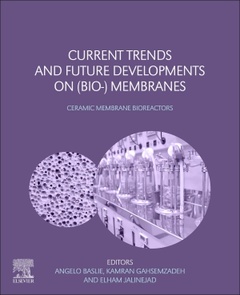Current Trends and Future Developments on (Bio-) Membranes Ceramic Membrane Bioreactors
Coordonnateurs : Basile Angelo, Ghasemzadeh Kamran, Jalilnejad Elham

Current Trends and Future Developments on (Bio-) Membranes: Ceramic Membrane Bioreactors presents the latest information on the application of ceramic MBR technology, including its maximum robustness and reliability when compared with other membrane-based systems. The book includes a comprehensive analysis of scenarios that are ideal for the potential use of ceramic MBRs. Sections cover applications, advantages/disadvantages, the modeling of ceramic membrane bioreactors, a comparison with other membrane systems, and a section on fouling mechanisms.
2. Silica MBR; design, configuration and performance
3. Titania MBR; design, configuration and performance
4. Alumina MBR; design, configuration and performance
5. Applications of ceramic MBR in water treatment
6. Applications of ceramic MBR in wastewater treatment
7. Separation theory and modeling of ceramic MBR
8. Fouling challenges in ceramic MBR
9. Cost assessment of ceramic MBR
R&D managers in industry interested in the membrane reactors and membrane bioreactors as well as academic researchers and postgraduate students working in the wider area of the membrane processes to energy conversion
Angelo Basile, a Chemical Engineer, is a senior Researcher at the ITM-CNR, University of Calabria, where he is responsible for research related to both the ultra-pure hydrogen production and CO2 capture using Pd-based Membrane Reactors. Angelo Basile's h-index is 53, with 387 document results with a total of 8,910 citations in 5,034 documents (www.scopus.com – 24 May 2023).
He has more than 170 scientific papers in peer-to-peer journals and 252 papers in international congresses; and is a reviewer for 165 int. journals, an editor/author of more than 50 scientific books and 120 chapters on international books on membrane science and technology; 6 Italian patents, 2 European patents and 5 worldwide patents. He is referee of 104 international scientific journals and Member of the Editorial Board of 22 of them.
Basile is also Editor associate of the Int. J. Hydrogen Energy and Editor-in-chief of the Int. J. Membrane Science & Technol. and Editor-in-chief of Membrane Processes (Applications), a section of the Intl J. Membranes. Basile also prepared 42 special issues on membrane science and technology for many international journals (IJHE, Chem Eng. J., Cat. Today, etc.). He participated to and was/is responsible of many national and international projects on membrane reactors and membrane science. Basile served as Director of the ITM-CNR during the period Dec. 2008 – May 2009. In the last years, he was tutor of 30 Thesis for master and Ph.D. students at the Chemical Engineering Department of the University of Calabria (Italy). From 2014, Basile is Full Professor of Chemical Engineering Processes.
Kamran Ghasemzadeh is currently working as a senior research associate at the chemical engineering department, University of Manchester, UK since August 2022. At the same time, he has served as an associate professor in the chemical engineering department at Urmia University of Technology, Iran, wherein he developed research on me
- Presents comprehensive coverage of ceramic membranes and ceramic membranes-based bioreactors
- Describes the various types of ceramic membranes, i.e., silica, titanium, and more
- Explains the mechanisms of action and the reasons behind the superiority of these membranes over other types
- Lists various applications of ceramic membrane bioreactors
Date de parution : 09-2019
Ouvrage de 282 p.
19x23.4 cm
Thème de Current Trends and Future Developments on (Bio-) Membranes :
Mots-clés :
Alumina membrane; Anaerobic biodegradation; Anaerobic membrane bioreactors; Applications; Biochemical oxygen demand; Biofuel production; Ceramic MBR applications; Ceramic MBR; Ceramic membrane cost; Ceramic membranes; Ceramic; Chemical oxygen demand; Clay membranes; Composite membranes; Desalination; Flat sheet; Fouling; Glass membranes; Industrial and municipal wastewater treatment; Membrane bioreactor; Membrane bio-reactor; Membrane bioreactors; Membrane fouling; Membrane modules; Nitrification; Performance improvement; Silica containing wastes-based membranes; Silica membranes; TiO2Titania; Wastewater treatment; Wastewater; Zeolite membranes



